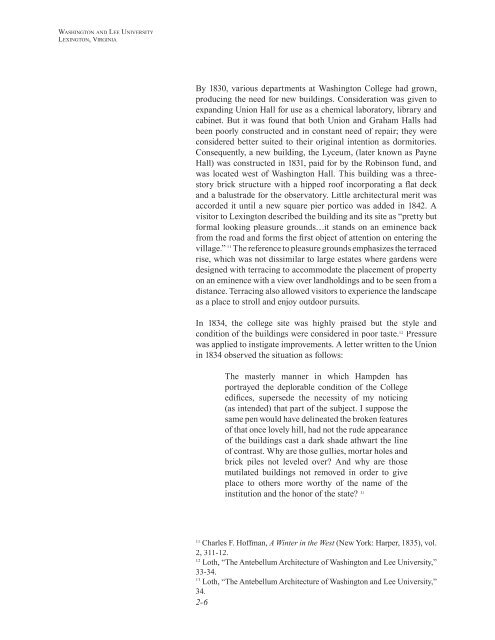A BRIEF HISTORY OF WASHINGTON AND LEE - Society for ...
A BRIEF HISTORY OF WASHINGTON AND LEE - Society for ...
A BRIEF HISTORY OF WASHINGTON AND LEE - Society for ...
Create successful ePaper yourself
Turn your PDF publications into a flip-book with our unique Google optimized e-Paper software.
<strong>WASHINGTON</strong> <strong>AND</strong> <strong>LEE</strong> UNIVERSITYLEXINGTON, VIRGINIABy 1830, various departments at Washington College had grown,producing the need <strong>for</strong> new buildings. Consideration was given toexpanding Union Hall <strong>for</strong> use as a chemical laboratory, library andcabinet. But it was found that both Union and Graham Halls hadbeen poorly constructed and in constant need of repair; they wereconsidered better suited to their original intention as dormitories.Consequently, a new building, the Lyceum, (later known as PayneHall) was constructed in 1831, paid <strong>for</strong> by the Robinson fund, andwas located west of Washington Hall. This building was a threestorybrick structure with a hipped roof incorporating a flat deckand a balustrade <strong>for</strong> the observatory. Little architectural merit wasaccorded it until a new square pier portico was added in 1842. Avisitor to Lexington described the building and its site as “pretty but<strong>for</strong>mal looking pleasure grounds…it stands on an eminence backfrom the road and <strong>for</strong>ms the first object of attention on entering thevillage.” 11 The reference to pleasure grounds emphasizes the terracedrise, which was not dissimilar to large estates where gardens weredesigned with terracing to accommodate the placement of propertyon an eminence with a view over landholdings and to be seen from adistance. Terracing also allowed visitors to experience the landscapeas a place to stroll and enjoy outdoor pursuits.In 1834, the college site was highly praised but the style andcondition of the buildings were considered in poor taste. 12 Pressurewas applied to instigate improvements. A letter written to the Unionin 1834 observed the situation as follows:The masterly manner in which Hampden hasportrayed the deplorable condition of the Collegeedifices, supersede the necessity of my noticing(as intended) that part of the subject. I suppose thesame pen would have delineated the broken featuresof that once lovely hill, had not the rude appearanceof the buildings cast a dark shade athwart the lineof contrast. Why are those gullies, mortar holes andbrick piles not leveled over? And why are thosemutilated buildings not removed in order to giveplace to others more worthy of the name of theinstitution and the honor of the state? 1311Charles F. Hoffman, A Winter in the West (New York: Harper, 1835), vol.2, 311-12.12Loth, “The Antebellum Architecture of Washington and Lee University,”33-34.13Loth, “The Antebellum Architecture of Washington and Lee University,”34.2-6
















